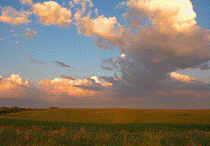North American Prairie Conference
Date of this Version
1989
Document Type
Article
Abstract
Re-vegetation of deteriorated mixed prairie by sod seeding with a lo-till planter minimizes erosion. Critical periods of inter- and intraspecific competition must be identified to design effective methods of sod suppression and seeding rate. Sod seeding studies were conducted in two counties in south central Nebraska over a 3-year period on a silty range site (fine-silty, mixed, mesic, Typic Argiustolls). Sites were dominated by blue grama [Bouteloua gracilis (H.B.K.) Lag. ex Steud.] and buffalograss [Buchloe dactyloides (Nutt.) Engelm.]. Warm-season native grasses were sod seeded with and without chemical sod suppression. Sod seeding required sod suppression for consistent stand establishment. Sod suppression during the 8-week period following seeding maximized grass seedling emergence. Seedling and stand vigor were more vigorous following sod suppression. Seedling development was independent of seeding rate, and a seeding rate of 20 PLS/0.l m2 resulted in an adequate stand. Spring-applied glyphosate [N (phosphonomethyl)-glycine] was effective at 0.8 kg/ ha using a reduced carrier volume (93 l/ha). August application of glyphosate coupled with a spring application of atrazine [6-chloro-N-ethyl-N' -(l-methylethyl)-1,3 ,5-triazine-2,4-diamine] at the time of seeding was also an effective sod suppression treatment.



Comments
Published in Prairie Pioneers: Ecology, History and Culture: Proceedings of the Eleventh North American Prairie Conference, August 7-11, 1988, Lincoln, Nebraska (Lincoln, NE 1989).